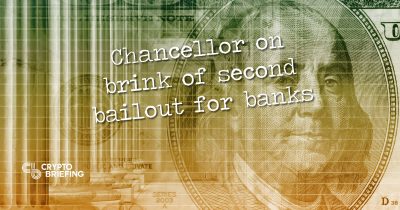Breaking Bitcoin: Another Mortgage Meltdown Will Prove The Case For Crypto
There will be no Satoshi Nakamoto II. Lessons must be learned.

Share this article
The subprime mortgage crisis triggered the global financial crisis that, in turn, triggered the bank bailouts and the quantitative easing cycle that followed to prop up a weakened U.S. and global economy.
Bitcoin was created amid the wreckage, taking aim at government-controlled printing presses in its genesis block. But there is growing evidence that the housing crisis has never recovered, with many Americans still underwater and at risk of default.
A second crisis could trigger a second bitcoin revolution. It could take us back to the dark days of bailing out institutions considered too big to fail and, perhaps, generate a newfound and more widespread appreciation of the promise of cryptocurrency.
In fact, a second mortgage meltdown might be the final capitulation of the broken financial system – which might be painful for many. But it may also break the cycle of debt and greed that continued deregulation has enabled.
Re-Default Figures Showing Fault Lines
After the subprime debacle, millions of mortgages were modified to prevent U.S. homeowners from falling into default. There have been close to ten million mortgage modifications made since the end of 2007.
Those modifications were in addition to the almost 17 million more temporary changes lenders made to mortgages to keep people from defaulting. Most of those take the form of deferring delinquent payment obligations to the future and payment reductions. These 17 million mortgages remain classified as current. They are a hidden problem.
Between 2008 and 2012, the U.S. Office of the Comptroller of the Currency (OCC) reported that lenders had modified around three million loans. By early 2013, 47 percent of them were still current. The other half had been foreclosed, were at risk of foreclosure, seriously delinquent, or sold to another service provider.
These, remember, are mortgages that had already been modified to ease the burden on homeowners. In half the cases, the changes didn’t help. More recently, in Q1 2019, 21 percent of the most recently modified loans had re-defaulted within a mere six months.
A 2015 Fitch Ratings report found that re-default rates were rising. They note that almost all modifications made in 2011 were first modifications. By 2015, one-third of modifications were second or third modifications, and with each modification, the risk of default rose.
And the Mortgage Crisis Ain’t Gettin’ Any Better
The Q1 2019 Federal Housing Finance Administration’s (FHFA) Foreclosure Prevention Report found that in Q4 2017, half of the modified loans in the prior year were current and performing. Meaning the other half were in serious trouble.
All of these studies paint a solemn picture. Once the $819 billion worth of still outstanding subprime-era mortgage defaults are excluded, half of those homeowners who remained able to continue living in their homes after a mortgage modification were likely to fall into default. It is a classic slow-burn lingering of the subprime crisis, which would be profoundly worse without a prolonged period of low interest rates.
Jump ahead to 2019, and JP Morgan revealed $10 billion worth of modified loans, with 43 percent of those having re-defaulted. 41 percent of Bank of America’s modified loans had since re-defaulted.
These brewing problems hide a more insidious problem: according to the OCC’s Mortgage Metrics Report, up to 95 percent of modifications made over the past five years have included adding interest owed in arrears back onto the mortgage. Lenders haven’t made mortgages easier to pay, they’ve merely delayed the repayment burden to avoid a foreclosure event.
While the bureau is upbeat in its Q2 2019 report, showing that over “96.1 percent of mortgages were current and performing”, those mortgages exclude modified mortgages and count those 17 million with temporary adjustments as “current”.
It is not difficult to speculate that foreclosures that would ordinarily have occurred have not occurred because of the modification process, and that process simply postpones inevitable foreclosures, as the evidence appears to be showing.
The return of quantitative easing on speed could finally hammer the last nail in the coffin of any faith people have left in legacy banking.
It could signal a Breaking Bitcoin moment.
There will not be a Satoshi Nakamoto II to intervene if economic growth continues to stall and housing weakness persists. Current mortgage problems are a spillover of the GFC.
It is often said that people learn best from mistakes.
But the moral hazard the Fed created by bailing out ‘too-big-to-fail’ institutions meant important lessons were never actually learned.
Share this article
